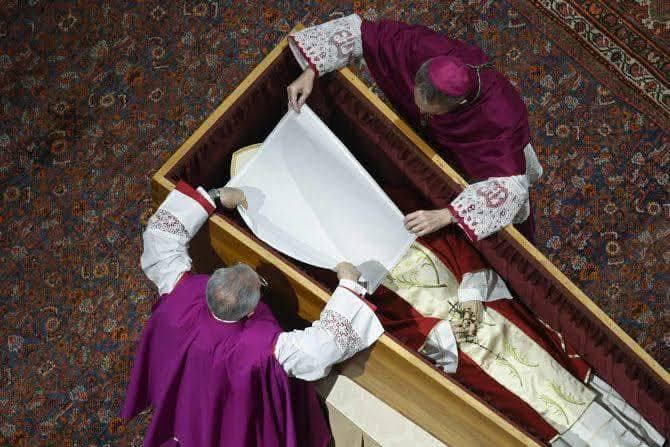This may be familiar to many Catholics, but not everyone is aware that when a Pope passes away, he is buried in three coffins: one made of cypress, another of lead, and the outermost of elm.
These coffins are placed one inside the other before interment.
Below are the reasons behind this tradition:
• THE CYPRESS COFFIN:
The innermost coffin is made of cypress and contains the Pope’s body, along with a copy of the funeral Mass eulogy and three bags of coins, one each of silver, gold, and copper. The number of coins in each bag corresponds to the number of years the Pope served.
Cypress, a simple wood, symbolizes humility and mortality, reminding us that the Pope, despite his status, is an ordinary human and is buried like any other man. This coffin is sealed and tied with three silk ribbons before being placed inside the lead coffin.
• THE LEAD COFFIN:
The sealed cypress coffin is then enclosed in a lead coffin, which is soldered shut. It bears engravings of the Pope’s name, the dates of his papacy, and a skull and crossbones—an ancient symbol known as memento mori, Latin for “remember you will die.”
This serves as a constant reminder of human mortality. The lead coffin also contains significant documents issued by the Pope during his lifetime, along with his broken seal of office, which was placed inside by the Camerlengo before final closure. This coffin protects these items for posterity.
• THE ELM COFFIN:
Finally, the lead coffin is placed inside an elm coffin, which is nailed shut with golden nails. Elm, one of the most precious woods available in Rome, represents the dignity and significance of the papal office.
Before sealing the coffins, a bishop reads aloud the official list of the Pope’s achievements. This list is then written on parchment, rolled up, placed inside a copper tube, and enclosed within the coffin.
Once sealed, the coffin is bound with two cords of violet silk and sealed with wax bearing the coat of arms of the Chamberlain and the Cardinal Dean. Thanks to this ancient custom, many historical documents of the Church have been well preserved.
Why Three Coffins?
-
Spiritual Symbolism: The three layers represent the journey of the soul (body, spirit, eternity).
-
Historical Protection: In the past, lead coffins were used to protect remains from exhumation or desecration.
-
Dignity and Honor: The triple-casket ritual underscores the respect given to the spiritual leader of over a billion Catholics.
This tradition, last seen during the funerals of Popes John Paul II and Benedict XVI, continues to inspire awe and solemn reflection, linking the modern Church to its deep historical roots



















